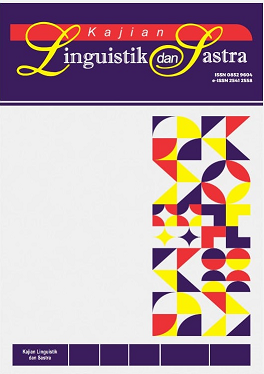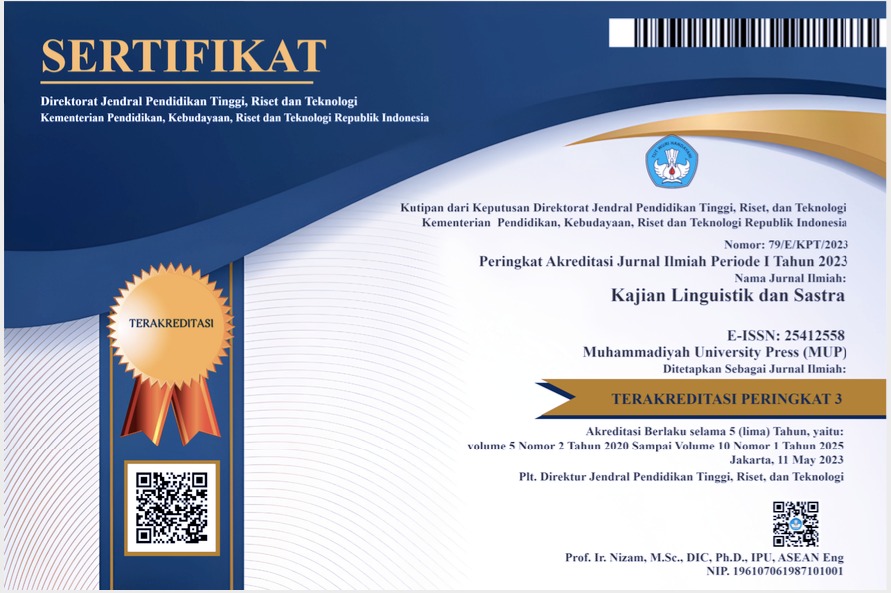Natural Equivalence in Literal Translation: A Case Study of the Bilingual Magazine LINGO
DOI:
https://doi.org/10.23917/kls.v9i2.7113Keywords:
bilingual magazine, literal translation, natural equivalenceAbstract
Literal translation is often used to maintain fidelity to the source text when translating into the target language. This study focuses on the application of the concept of natural equivalence in the context of literal translation in the bilingual magazine LINGO. The main objective of this study is to explore the extent to which literal translation is used in LINGO and how natural equivalence can be achieved to improve the quality of translation. The research method involves an in-depth analysis of the original and translated texts of LINGO magazine to assess the use of literal equivalents and their impact on the naturalness of the target language. The study also aims to identify areas where natural equivalence could be better used, and to suggest strategies for overcoming the problems associated with overly literal translation. The implication of these findings is the importance of using natural equivalence in translation to improve the readability and naturalness of the text. Since 53% of translation methods employed are based on literal translation, it is expected that this study provides valuable insights into the application of the concept of natural equivalence in literal translation, and a basis for further research to improve translation practices in bilingual publications.
Downloads
References
U. Rosalina, V. P. Darma, N. N. R. Fauzah, and R. N. Qudwatullathifa, “English-Indonesian Translation Methods in the Subtitle ‘Mariposa and the Fairy Princess’ Movie,” J. Educ., vol. 6, no. 2, pp. 11908–11916, 2024, doi: https://doi.org/10.31004/joe.v6i2.4995.
A. A. Rois, A. J. Kirana, L. Setyowati, and S. D. Arum, “the Impact of Translation Techniques on Assertive Speech Act of Inez Product Pakaging,” Kaji. Linguist. dan Sastra, vol. 5, no. 2, pp. 123–136, 2021, doi: 10.23917/kls.v5i2.10984. DOI: https://doi.org/10.23917/kls.v5i2.10984
D. Assegaf, Jurnalistik Masa Kini. Jakarta: Galia Indonesia, 1983.
R. A. Fauzi and T. Tressyalina, “Alih Kode dan Campur Kode dalam Transaksi antara Penjual dan Pembeli di Pasar Modern Teluk Kuantan Riau,” Kaji. Linguist. dan Sastra, vol. 5, no. 2, pp. 113–122, 2021, doi: 10.23917/kls.v5i2.11000. DOI: https://doi.org/10.23917/kls.v5i2.11000
E. A. Nida and C. R. Taber, The Theory and Practice of Translation. Netherland: Koninklijke Brill NV, 1969.
Y. V Sokolovsky, “On the Linguistic Definition of Translation,” J. Sib. Fed. Univ., vol. 2, no. 2010 3, pp. 285–292, 2010.
U. Rosalina and Y. T. Damayanti, “Analysis Translation Strategies in ‘Anti-Hero’ Song By Taylor Swift in English to Indonesian Language,” NextGen Educ. Rev. J., vol. 1, no. 1, 2023, doi: DOI:10.58660/nextgen.v1i1.28. DOI: https://doi.org/10.58660/nextgen.v1i1.123
E. R. Wendland, “Review Article: Jeremy Munday , Introducing Translation Studies: Theories and Applications,” Ote, vol. 25, no. 2, pp. 421–454, 2012.
J. C. Catford, A linguistic theory of translation. London: Oxford University Press. London: Oxford University, 1965.
E. A. Nida, Language structure and translation: Essays. Stanford: Stanford University Press, 1975.
P. Newmark, Approaches to Translation, vol. 65, no. 2. Great Britain: A. Wheaton & Co. Ltd, 1981. doi: 10.1111/cura.12479. DOI: https://doi.org/10.1111/cura.12479
R. Hartono, Pengantar Ilmu Menerjemah (Teori dan Praktek Penerjemahan). Semarang: Prima Nusantara, 2017.
P. Newmark, About Translation: Multilingual Matters. Clevedon, Philadelphia, Adelaide: Multilingual Matters Ltd., 1991.
P. D. A. Hikmaharyanti and K. H. O. Wisudayan, “Konsep Padanan Alamiah Dalam Penerjemahan Harfiah Majalah Dwibahasa LINGO: Solusi dan Implikasi,” Pros. Semin. Nas. Linguist. dan Sastra, pp. 248–259, 2024, [Online]. Available: https://e-journal.unmas.ac.id/index.php/semnalisa/article/view/9162
H. Hasiyanti and I. Maisarah, “Translation Procedures in Subtitle ‘How Every Child Can Thrive By Five’ Video,” English Educ. English J. Teach. Learn., vol. 10, no. 01, pp. 16–25, 2022, doi: 10.24952/ee.v10i01.5227. DOI: https://doi.org/10.24952/ee.v10i01.5227
T. N. Fitria, “Translation Procedure of English to Indonesian Subtitle ‘English Vinglish’ Movie,” Rainbow J. Lit. Linguist. Cult. Stud., vol. 9, no. 1, pp. 40–48, 2020, doi: 10.15294/rainbow.v9i1.38132. DOI: https://doi.org/10.15294/rainbow.v9i1.38132
R. M. Simamora and A. Priyono, “Translation Method Analysis on Figurative Language in Novel Crazy Rich Asians Translated into Kaya Tujuh Turunan,” JENTERA J. Kaji. Sastra, vol. 11, no. 2, p. 341, 2022, doi: 10.26499/jentera.v11i2.5265. DOI: https://doi.org/10.26499/jentera.v11i2.5265
K. B. Batubara, R. A. Sinurat, I. F. Sebayang, and V. C. Bukit, “The Application of Translation Techniques in Translating,” Transform J. English Lang. Teach. Learn., vol. 11, no. 4, p. 237, 2023, doi: 10.24114/tj.v11i4.46655. DOI: https://doi.org/10.24114/tj.v11i4.46655
J. F. Fraenkel, N. E. Wallen, and H. H. Hyun, How to Design and Evaluate Research in Education. New York: Mc Grow Hill, 2015.
J. S. Wodarski, H. M. J, and M. D. Feit, “Assessment Methods,” in Evidence-Informed Assessment and Practice in Child Welfare, London: Springer International Publishing/Springer Nature, 2015, pp. 99–121. DOI: https://doi.org/10.1007/978-3-319-12045-4_7
J. W. Creswell, Qualitative Inquiry and Research Design: Choosing among Five Approaches. New York: Sage Publication, 2007. doi: 10.1111/1467-9299.00177. DOI: https://doi.org/10.1111/1467-9299.00177
E. J. Tisdell and S. Merriam, Qualitative Research: a Guide to Design and Implementation. Hoboken: Jossey Bass A Willey Brand.
T. N. Fitria, “Analysis of Word Formation Process in Online Shop’S Terminologies,” Kaji. Linguist. dan Sastra, vol. 7, no. 2, pp. 176–189, 2022, doi: 10.23917/kls.v7i2.15511. DOI: https://doi.org/10.23917/kls.v7i2.15511










